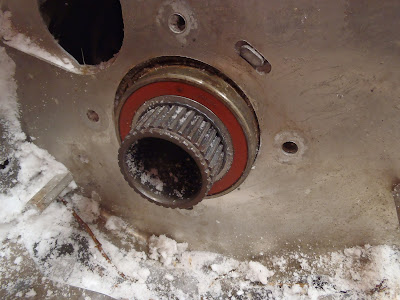Modern ATVs use constant velocity (CV) joints on their drive shafts. These joints allow the rotating axles to change direction as the suspension goes up and down or the wheels steer left and right. They serve the same purpose as U joints did on older vehicles. CVs are more complicated and expensive to manufacture than U joints, but they provide a smoother transfer of power and they are normally longer lasting due to the rubber boot that protects the moving parts from water and dirt. This is the same type of system used on front wheel drive automobiles.
The only maintenance required on them is to inspect the boots and replace them if they are torn or cracked. Lately I have been replacing a lot of CV boots for people. I think that the very cold (-30) weather that we had this past winter caused the boot to crack.
The joints come in two styles, one has a fixed length and the other style can "plunge". This plunging action allows the length of the axle to change slightly as the vehicle suspension moves. The upper joint in this photo is a fixed length, the bottom green one is the plunge joint. Most axles have a fixed length joint on the outboard end and a plunge joint on the inboard end.
The fixed length joint pulls out of the wheel hub once the large nut on the end is removed. The plunge joint that goes into the differential is a little trickier to remove. It is held in place by a little spring clip on the end of the splined shaft. Too remove the axle from the housing you push the axle all the way in as far as it will plunge, then quickly pull the axle out. If you do it correctly the axle acts like a slide hammer and it will pop the shaft right out of the differential.
The first step to servicing the CVs is to get the old boots off. The clamps holding them on come in several different styles. On some of them it is easy to bend the tabs up to release them, on the stubborn ones I use a cutoff wheel to cut them.
Once the boots are off you must take the joints apart to clean the old grease and any contamination out.
The above photo shows how a plunge type joint comes apart. There is a wire snap ring the fits in a groove inside the mouth of the CV cup. Pop that ring out with a small pick or screw driver and the cup will pull right off. Once the cup is off there is an external snap ring on the end of the shaft that holds the center of the joint on.
The above photo shows a fixed length joint that has been removed from the shaft. These are held on the shaft by a spring clip in a groove on the end of the shaft. When the joint is together there is no access to this clip. You must force the joint off the shaft over the top of the clip.
Here is the setup that I use to hold the shaft while I pound the joint off. I have the shaft clamped in a couple of v blocks on the corner of my work bench. The v blocks are sitting on top of a heavy counter weight from a tractor. I use this as an anvil, the extra weight makes any pounding that you are going to do much more effective.
Once the axle is secured to something solid I used a large punch and a hammer to drive the center piece of the joint off the end of the shaft.
Carefully lay out the parts in the order that you take them apart. It is important to remember which side of each part goes on the shaft first. The pieces are not quite symmetrical and they will only fit together one way. Even the small snap ring that goes on the end has a inside and outside face. Check out
this older post for a description of how the snap ring goes and other CV tips.
After cleaning up the parts and inspecting everything it is time to reassemble. I have been using boots from
Moose with good success. Their standard generic size boot will fit most machines and they also have custom size boots to fit just about any odd size machine. Since I do a lot of these I purchased their fancy boot clamp tool. It works a lot better than the free one that come with the replacement boots. If you have very many to do it is worth it.
Here is the finished axle ready to go back into the machine.


















































